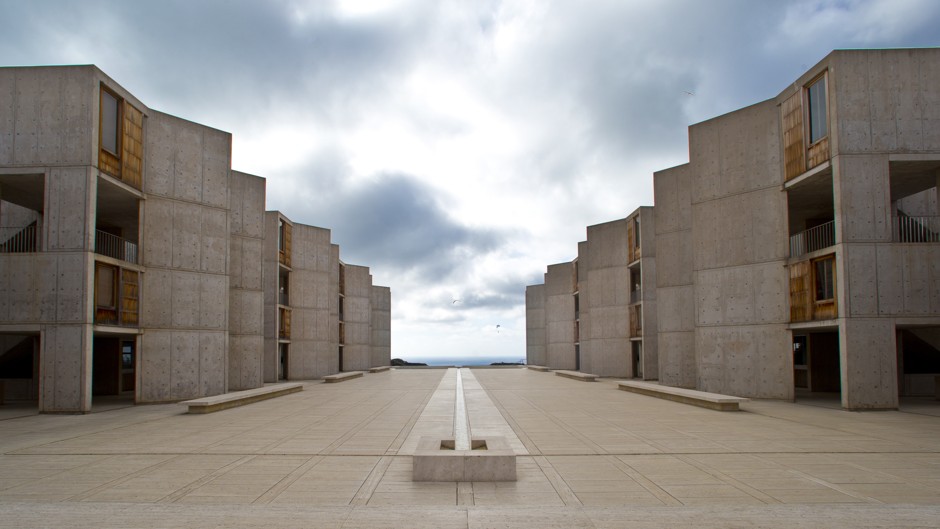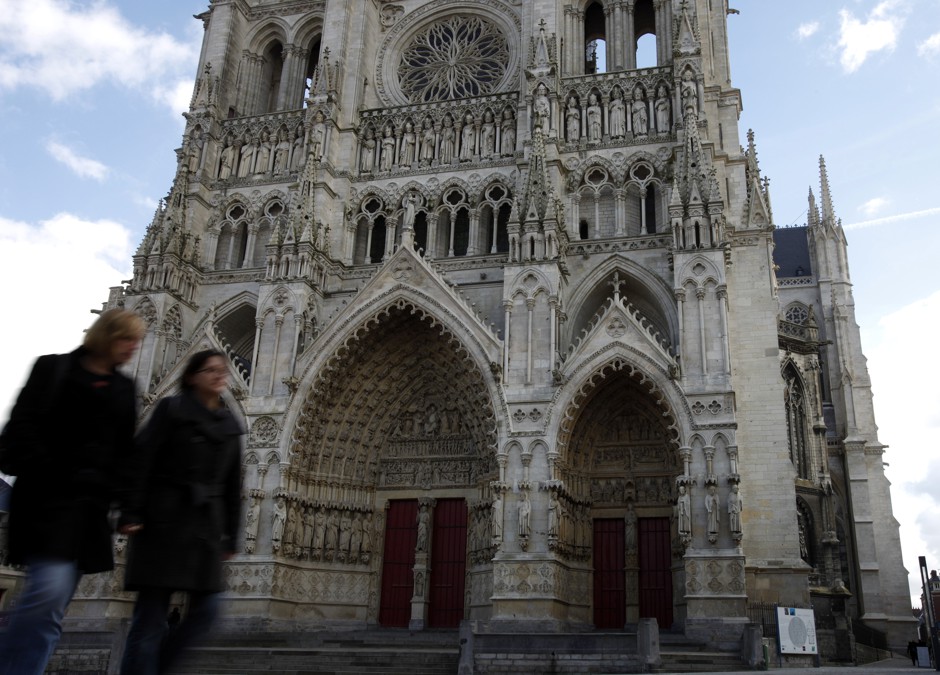
The Salk Institute near San Diego is considered one of Louis Kahn's masterpieces. Photo by Lenny Ignelzi/AP .

Through scale, vertical composition, and sound, Amiens Cathedral in France “forces us to relinquish some measure of control, surrendering it to something amorphous and ill-defined,” Goldhagen writes. Photo by Pascal Rossignol/Reuters .
One of your chapters is titled “The Sorry Places We Live,” and you refer throughout the book to the “beggary” of the built environment. What are the most flagrant sins that buildings and cities commit against human wellbeing?
Oh my gosh, the list is long! One thing I often say is there’s no such thing as a neutral environment. If the environment we inhabit— whether cityscapes or landscapes or buildings—is not supporting us, it’s probably harming us.
[Cities] undervalue the importance of the design of the built environment altogether. There is this sort of professional split between high architecture and building, which my research shows is just fallacious. It’s all architecture and it’s all important, because it’s all having an impact on people all the time.
More specifically, very often in cities, the overall form of buildings is given much more priority than materials, surfaces, textures, and details. What we know about the way we appropriate and experience places is that the overall form of a place is not what most dramatically affects our experience of it. It’s more what psychologists call the surface-based cues.
Architects tend, particularly with parametric design, to emphasize overall aggregate form, and all that other stuff gets filled in later. And then, very often, it’s value-engineered out. That’s what’s creating a lot of the impoverishment in the environment. To have “sticky” places—places that engage you, your sensory system, your motor system, [and] help you create a sense of identification with [them]—you have to have all those things, and most buildings don’t.
Another thing is differentiated, non-repetitive surfaces. [The psychologist and author] Colin Ellard did a study of how people respond: He basically put sensors on people and had them walk by a boring, generic building. Then he had them walk past something much more variegated with more ways to [engage] visually and therefore motorically. He found that people’s stress levels, measured by cortisol, went up dramatically when they were walking past the boring building.

Created for the World Expo in Shanghai in 2010, Thomas Heatherwick’s Seed Cathedral pavilion, with 60,000 swaying acrylic rods, “inspired gentle delight,” writes Goldhagen. Photo by Aly Song/Reuters .

The tips of the rods were embedded with seeds, the kind of varied, tactile surface details that Goldhagen says are crucial for our engagement with the built environment. Photo by Aly Song/Reuters .
The reason I emphasize non-conscious [cognition] is because most people are very bad at knowing why we’re feeling or thinking the things we are. You could be walking past that boring building and you ascribe your stress to a bad conversation you had with someone the other day. But cognition is embodied, and you’re standing next to this soul-desiccating place, and that’s what’s going on.
The book is peppered with the findings of scientific research on how the environment shapes us and our lives. The brains of London cab drivers actually change after they memorize the city’s geography. The design of a school can account for up to 25 percent of a child’s rate of learning. Why haven’t these findings upended architectural education?
I had architectural education very much in mind when I was writing the book. I taught in architecture schools for 15 years, good ones. The most obvious part of the answer is that architectural training is really, except for the technical and engineering part of it, based in the Beaux-Arts design tradition. Nobody’s really looking at the sciences.
Number two, the information which I draw in the book to construct this paradigm of how people experience the built environment comes from a lot of different disciplines. Cognitive neuroscience, environmental psychology, evolutionary psychology, neuroanthropology, ecological psychology. In most cases, the studies that I was looking at and ended up finding most useful were not necessarily about the built environment. It was up to me to look at a study on how people respond to water surfaces versus mirrors, and then figure out what that meant for the design of the built environment.
Another reason is that in the academy, the effect of poststructuralism and identity politics has been to hammer into people’s heads the notion of cultural relativism: “You can’t possibly say things about how people experience the world because it’s all culturally constructed, socially constructed; it differs by gender, by locale.” And so the other dimension was that talking about individual experience, even if it’s related to social experience, but from an embodied-cognition point of view, meant that you were apolitical. Because you were talking about something very subjective and individual. So it was kind of forbidden territory.
The embodied-cognition approach is universalizing, although you make it clear that any design guidelines arising from it leave room for different social and cultural responses. Is it easier, or harder, to take this approach now than it would have been 10 or 15 years ago?
I don’t think it’s coincidental that I’m not in the academy and I wrote this book. I don’t want to sound like I’m attacking architectural education because there are plenty of people out there doing great things. This book basically started with an essay on Alvar Aalto and embodied cognition and metaphors, in a book edited by Stanford Anderson. I presented this when I was still teaching at Harvard, and people went nuts. They just went crazy. “Wait a minute, you’re making all these universalist claims!”
My response to that was, and remains, “Sure, there are a lot of things that are socially constructed. All you have to do is read my earlier work; it’s not like I disagree with those ideas. The fact is that humans live in bodies, and brains work in certain ways.”
There’s this dichotomy between those who [think] about architecture in social and political terms, and those who [think] about subjective experience, and never the twain shall meet. One of the things the book does is basically dissolve that opposition. The critical wink is the work of this [psychologist] Roger Barker, who had researchers assigned to kids. [The researchers] followed them around and took notes. Breakfast, school, chess club, ballet. The conclusion was they could tell more about the kids by looking at where they were than by looking at who they were. Their individual psychology mattered a lot less in terms of their experience and behavior than the environments they were in.
So there isn’t this opposition between looking at it as a social construct versus experiential construct. It’s all the same thing. It’s a continuum.
One thing I kept thinking while reading the book was how little agency we really have. Have you gotten pushback on that? I can imagine some people saying, “No way is the environment shaping my thoughts to this degree.”
If people thought that, they didn’t say it to me. I think people are more ready to accept it than they were 10 or 15 years ago. The mind-body connection has become so apparent. We know now, for example, that how we hold our body affects our mood. If you’re depressed and your shoulders are hunched forward, you’ll actually help yourself if you straighten up.
The second thing is behavioral economics, which I think has been really key, and has been adopted into policy. People don’t make decisions logically. They make decisions based on association and fallacious heuristics. I think that has paved the way for people to recognize, “I don’t have as much agency as I thought I did.” The paradox is, with a book like this, I’m hoping to enhance people’s agency with their awareness of it.
You argue that “enriched environments” should be a human right, included in the UN’s Human Development Index. What has to happen next for human-centered design to become not a luxury, but the norm?
Well, a lot. One of the reasons the book is targeted to a general audience is that basically, we need a real paradigm shift in how we think about the built environment. It’s kind of analogous to the paradigm shift that happened in the 1960s and the way people thought about nature.

Designed by Enric Miralles and Benedetta Tagliabue, the Scottish Parliament in Edinburgh embodies experiential design for Goldhagen, with its ample daylight, patterned complexity, and rich materials creating a sense of uplift. Photo by Andrew Milligan/Reuters .
When I was really young kid, nature was nature. It was forests, trees, lakes, rivers. Then people begin to use the word “environment.” It was a political and social construct, and emphasized the interrelatedness of all these different components within nature. That was a response to pesticides, air pollution, and so on. Now, kids get education in the environment from the time they’re in first grade. They start learning about climate change, visit waste treatment plants. That’s the kind of paradigm shift that needs to happen about the built environment. Then it suddenly becomes of general public health importance.
What concretely needs to happen: One, architectural education. Two, real-estate development. Three, building codes, zoning codes, all these things need to be reviewed according to these kinds of standards. Four, architects need to not be so skittish in thinking about human experience and learn more about it. It’s a much larger problem than just, “Architects should do better.” It’s not a professional disciplinary problem, it’s a larger social problem. We also need more research.
I was at a book event where Richard Roberts [a former New York City housing commissioner] said, “I’m going to recommend to every public official I know that they read this book.” I’ve had a lot of architects tell me that they gave the book to clients.
That seems smart.
Yeah, no joke. We need general education about the built environment that starts very early on. So there are a lot of things that need to change. But they can.